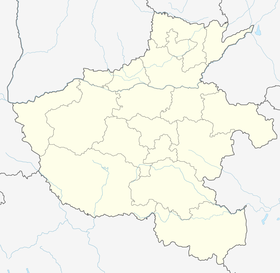
Back كهوف لونغمن Arabic Covarones de Longmen AST Lunmen mağaraları Azerbaijani Лунмэнь Byelorussian Лунмън (пещера) Bulgarian ལུང་མོན་བྲག་ཕུག Tibetan Grutes de Longmen Catalan Jeskyně Lung-men Czech Longmengrotterne Danish Longmen-Grotten German
| UNESCO World Heritage Site | |
|---|---|
 Lu She Na Buddha | |
| Location | Luolong District, Luoyang, Henan, China |
| Criteria | Cultural: i, ii, iii |
| Reference | 1003 |
| Inscription | 2000 (24th Session) |
| Area | 331 ha |
| Buffer zone | 1,042 ha |
| Coordinates | 34°33′20″N 112°28′11″E / 34.55556°N 112.46972°E |
| Longmen Grottoes | |||||||||||||||||||||
|---|---|---|---|---|---|---|---|---|---|---|---|---|---|---|---|---|---|---|---|---|---|
 "Longmen" in Simplified (top) and Traditional (bottom) Chinese characters | |||||||||||||||||||||
| Simplified Chinese | 龙门石窟 | ||||||||||||||||||||
| Traditional Chinese | 龍門石窟 | ||||||||||||||||||||
| |||||||||||||||||||||


The Longmen Grottoes (simplified Chinese: 龙门石窟; traditional Chinese: 龍門石窟; pinyin: Lóngmén Shíkū; lit. 'Dragon's Gate Grottoes') or Longmen Caves are some of the finest examples of Chinese Buddhist art. Housing tens of thousands of statues of Shakyamuni Buddha and his disciples, they are located 12 kilometres (7.5 mi) south of present-day Luoyang in Henan province, China. The images, many once painted, were carved as outside rock reliefs and inside artificial caves excavated from the limestone cliffs of the Xiangshan (香山) and Longmenshan, running east and west. The Yi River (Chinese: 伊河) flows northward between them and the area used to be called Yique (伊阙; 'The Gate of the Yi River').[1][2][3] The alternative name of "Dragon's Gate Grottoes" derives from the resemblance of the two hills that check the flow of the Yi River to the typical "Chinese gate towers" that once marked the entrance to Luoyang from the south.[4] There are as many as 100,000 statues within the 2,345 caves, ranging from 1 inch (25 mm) to 57 feet (17 m) in height. The area also contains nearly 2,500 stelae and inscriptions, hence the name "Forest of Ancient Stelae", as well as over sixty Buddhist pagodas. Situated in a scenic natural environment, the caves were dug from a 1 kilometre (0.62 mi) stretch of cliff running along both banks of the river. 30% date from the Northern Wei and 60% from the Tang dynasty, caves from other periods accounting for less than 10% of the total.[3] Starting with the Northern Wei dynasty in 493 AD, patrons and donors included emperors, Wu Zetian, members of the royal family, other rich families, generals, and religious groups.[1][5]
In 2000 the site was added to the UNESCO World Heritage List as "an outstanding manifestation of human artistic creativity," for its perfection of an art form, and for its encapsulation of the cultural sophistication of Tang China.[2]
- ^ a b Longmen Grottoes Management Office (September 12, 2003). "Longmen Grottoes". Luoyang City, Henan: China.org.cn. Retrieved 18 May 2011.
- ^ a b "Longmen Grottoes". UNESCO World Heritage Centre. Retrieved 17 May 2011.
- ^ a b ICOMOS (September 2000). "Longmen Grottoes (China) No 1003" (PDF). Unesco.org. Retrieved 17 May 2011.
- ^ Fiala, Robert D. "Longmen Grottoes (carved 480s–900 onward)". orientalarchitecture.com. Retrieved 18 May 2011.
- ^ "Longmen Caves". sacred-destinations.com. July 24, 2009. Retrieved 17 May 2011.

